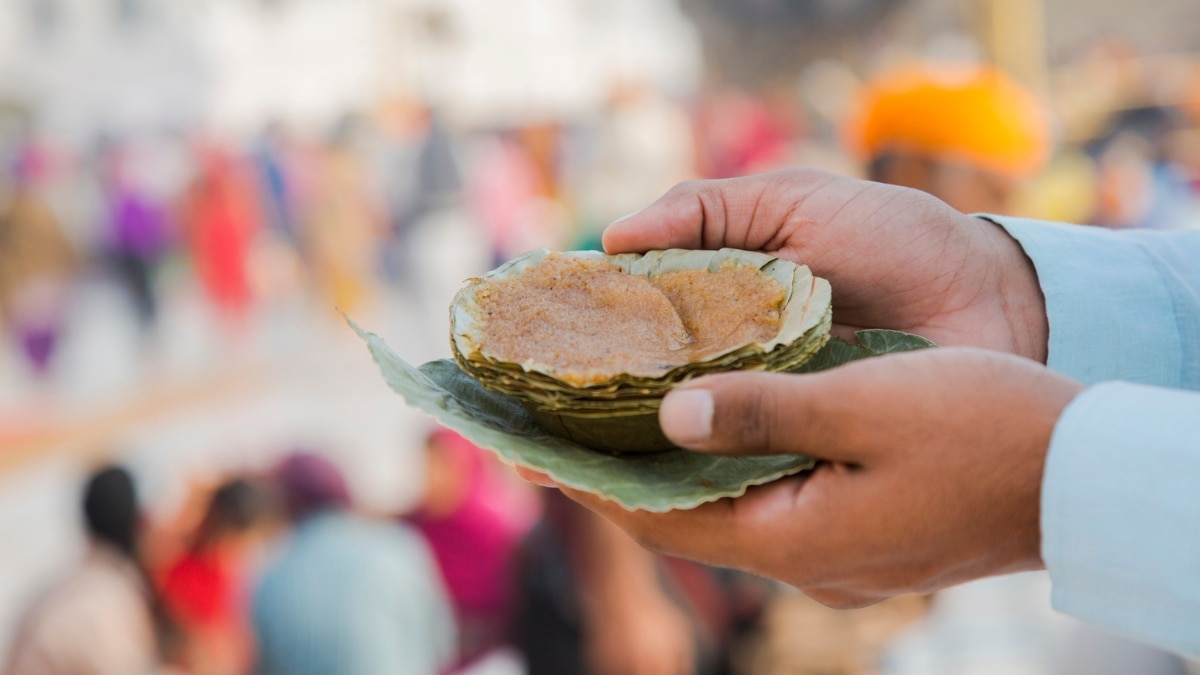Kada prasad: the golden-hued sweet treat that is the sacred star of Gurpurab
The Sikh festival is incomplete without a serving of the beloved dish.


It is Gurpurab today and it marks the birth of the first Sikh guru—Guru Nanak. One of the most holy days for Sikhs all over the world, it is celebrated by offering prayers in gurudwaras, eating langar (communal meal), and taking a sweet helping of kada prasad—the ghee-drenched steaming hot halwa. Bazaar India traces the dish’s origin story and the important place it holds in the heart of Sikhs.
From Turkey to gurudwaras—the journey of halwa
I’ve always wondered how the Middle Eastern halva (or halvah) and the India halwa share the same name but are so different in their identities. Turns out, they have more in common than I thought. The word halwa is derived from the Arabic word ‘hulw’, which means sweet. Many origin stories for halwa and how it came to India exist. Some legends say that the method of cooking halwa originated during the Ottoman Empire (1520 to 1566). The then-reigning Suleiman of the empire maintained a separate kitchen only for sweet items, and halwa was one of them. This Turkish sweet had three ingredients as its foundation—starch, fat and sweetener. Even today, that is one of the markers of halwa, no matter which part of the world it is made in—sweetener is dissolved in water first before starch (flour, grains or lentils) and fat (ghee or coconut oil in India) are added to it.
Closer home, the 13th century Arabic text, Kitab al-Tabikh, written by Muhammad ibn al-Hasan Ibn al-Karim, who had compiled a recipe book of Arabic dishes, is the first known text to mention halwa. The text mentions eight different varieties of halwa along with each of their recipes.
In The Illustrated Foods of India, food historian KT Achaya elaborates, “In India, it [halwa] connotes softly firm desserts made from a range of materials: wheat flour, wheat grits, vermicelli, Bengal gram flour, fruits like banana and date, nuts like almond and walnuts, and vegetables like pumpkins and dates.” Meanwhile, Chicago-based food historian Colleen Taylor Sen, in her book Feasts and Fasts, says that halwa arrived in Delhi Sultanate between the 13th and 16th centuries during the rule of Mohammad Bin Tughlaq. While we don’t know for certain when halwa made its way to Indian kitchens, we know that the dish came to the country through trade routes—the dish having its own versions in the port cities of Karachi and Kozhikode is testament to that fact. Both resemble the Turkish one more than the pudding-like dessert we are used to—they are gelatinous and sold in blocks, with the Karachi (or Bombay halwa as it is now more popularly known as) one containing corn flour to get that texture. The kada prasad on the other hand, resembles more the soft dough-like sweet dish found all over India.
What goes into kada prasad?
What we know as kada prasad is the quintessential atta ka halwa, which has its own variations in different households, but when it comes to the kada prasad in particular, it remains unchanged. Even though the Internet abounds with many recipes, most roughly feature the same ingredients—atta (whole wheat flour), ghee (clarified butter), sugar and water—and are cooked with the same ratio of 1:1:1:1. According to legend, the ratio is meant to symbolise equality between men and women. What lends kada prasad its rich, velvety and melt-in-the-mouth texture is the significant amount of ghee in the recipe, and elbow grease—continuously stirring the halwa so it doesn’t burn but instead turns smooth and nutty-brown. While the typical kada prasad made in large vats in gurudwaras is almost always served plain and simple without the addition of any dry fruits, home cooks usually take creative liberty and top theirs with nuts and raisins.
Kada prasad as a divine blessing
Seva, or service, lies at the heart of Sikhism. It is no surprise then that the act of serving kada prasad in gurudwaras also takes from this belief. Gurudwara translates to “the door to the guru”, and it is believed that a guru never sends back a devotee empty-handed or hungry. So, a sweet and divine blessing is offered in the form of kada prasad, which you accept by cupping your hands. Since the prasad is considered a sacred sweetmeat, it is rude to turn it down. Both the offering and receiving of this sweet signifies community service and hospitality—two virtues that are very close to the heart of Sikhs. The ones performing seva by serving food usually dole out equal quantities from a large bowl.
Lead image: Getty Images










